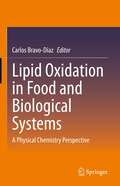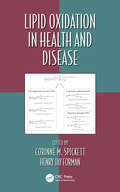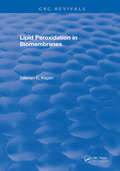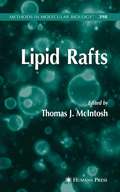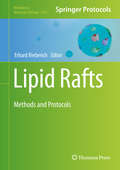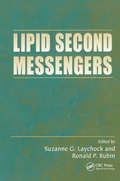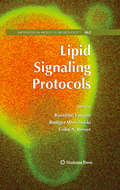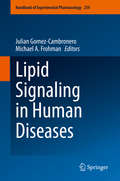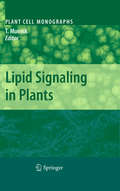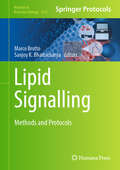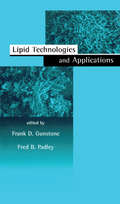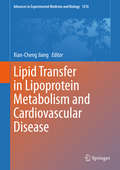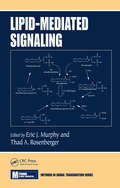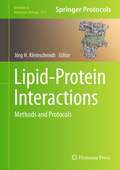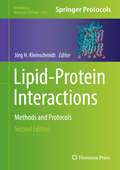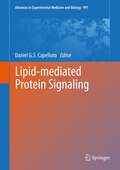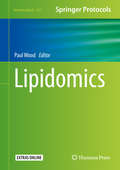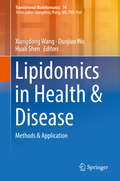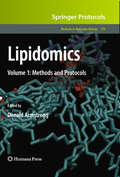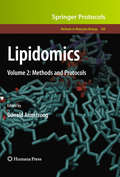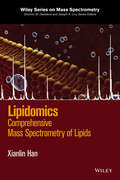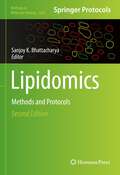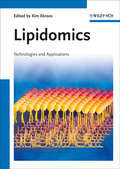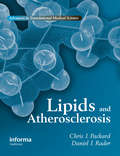- Table View
- List View
Lipid Oxidation in Food and Biological Systems: A Physical Chemistry Perspective
by Carlos Bravo-DiazThis book offers a new physical chemistry perspective on the control of lipid oxidation reactions by antioxidants, and it further explores the application of several oxidation inhibition strategies on food and biological systems. Divided in 3 parts, the book reviews the latest methods to control lipid oxidation, it examines lipid oxidation and inhibition in different food systems, and it finishes with an overview of the biological, health and nutritional effects of lipid oxidation. Chapters from expert contributors cover topics such as the use of magnetic methods to monitor lipid and protein oxidation, the kinetics and mechanisms of lipid oxidation and antioxidant inhibition reactions, interfacial chemistry, oxidative stress and its impact in human health, nutritional, sensory and physiological aspects of lipid oxidation, and new applications of plant and marine antioxidants. While focused on lipid peroxidation in food and biological systems, the chemistry elucidated in this book is applicable also to toxicology, medicine, plant physiology and pathology, and cosmetic industry. The book will therefore appeal to researchers in the lipid oxidation field covering food, biological and medical areas.
Lipid Oxidation in Health and Disease (Oxidative Stress and Disease)
by Corinne M. Spickett Henry Jay FormanOxidative modification of lipids and phospholipids-including radical damage, halogenation, and nitration-result in significant changes to the chemical properties of the molecules, which in turn have a major effect on their biochemical functions. Lipid oxidation has long been regarded as a deleterious process responsible for lipid rancidity, loss of
Lipid Peroxidation In Biomembranes
by Valerian E. KaganThis book will explain the colossal potential of life to cope with different living environments is possible owing to the exceptionally well developed mechanisms of adaptation to environmental conditions. There is an innumerable variety of concrete mechanisms which make it possible for living creatures to adapt to different and changing environmental conditions. Nevertheless, all this variety is the manifestation of the three strategic line of the adaptation process: 1. Evolutional or genotypic adaptation. 2. Phenotypic adaptation. 3. Rapid adaptation.
Lipid Rafts
by Thomas J. McintoshThere are many unanswered questions concerning the composition, structure, and dynamics of lateral microdomains (rafts) in biological membranes. Thus, sophisticated techniques have been used to study intact cell membranes as well as model systems composed of specific lipids and proteins thought to be in rafts. Using biochemical, biophysical, and computational methods, "Lipid Rafts" provides the most up-to-date information on the subject.
Lipid Rafts: Methods and Protocols (Methods in Molecular Biology #2187)
by Erhard BieberichThis volume gives a comprehensive insight into established and novel methods to analyze the structure and function of lipid rafts. This book covers topics such as isolation of lipid rafts and their functional analysis using biochemical methods; visualization of lipid rafts and their interaction with proteins using fluorescence-related methods; preparation of giant lipid vesicles and fluorescence spectroscopy; FRET and FRAP; and using photo-activated cross-linking of a ceramide analog combined with proximity ligation assay. Written in the highly successful Methods in Molecular Biology series format, chapters include introductions to their respective topics, lists of the necessary materials and reagents, step-by-step, readily reproducible laboratory protocols, and tips on troubleshooting and avoiding known pitfalls.Thorough and cutting-edge, Lipid Rafts: Methods and Protocols is a valuable resource for both novice and expert researchers interested in learning more about the function of lipid rafts in many areas of cell biology and medicine.
Lipid Second Messengers
by Suzanne G. Laychock; Ronald R RubinLipid Second Messengers provides detailed methodology for analysis of various lipid signaling pathways. Authoritative contributors explain the factors that regulate lipid second messenger production by agonist-activated enzymes and examine their products. Topics discussed include procedures used to measure lipid-derived mediators such as lysophospholipids, arachidonic acid, eicosanoids, anandamide, and ceramides, and the enzymes responsible for generating these messengers, such as phospholipases, prostaglandin endoperoxide synthases, and sphingomyelinase.
Lipid Signaling Protocols
by Colin A. Rosser Rudiger Woscholski Banafshé LarijaniLipid Signaling Protocols assembles in a single volume the various tools and methodologies needed by the interested investigator to unravel lipid dependent signaling and cell function. Divided into two convenient sections, the volume begins by summarizing the physical properties of hydrophobic metabolites as well as the physical methodologies used for their analysis, which leads to the second section and its selection of biological methods, focused around the most relevant lipids, their corresponding metabolizing enzymes and the recognition proteins. Following the highly successful Methods in Molecular BiologyTM series format, the chapters provide readily reproducible laboratory protocols, lists of necessary materials and reagents, and the tips on troubleshooting and avoiding known pitfalls. Contributed to by top researchers in the field, Lipid Signaling Protocols is an essential resource for both experienced and novice researchers who desire a better understanding of the application of physical methodologies in the context of lipid signaling and lipid metabolism in cell biology.
Lipid Signaling in Human Diseases (Handbook of Experimental Pharmacology #259)
by Julian Gomez-Cambronero Michael A. FrohmanLipids are an integral part of cell membrane architecture, are intermediaries in cell metabolism, and are involved in transmitting cell signals from hormones, growth factors and nutrients. A number of lipases and phospholipases, lipid kinases, lipid phosphatases, sphingosine kinases, and their reaction products have been implicated in fundamental cellular processes including cell proliferation, division and migration. These enzymes and their products underlie the molecular mechanisms of numerous human diseases, in particular metabolic disease (diabetes), cancer, neurodegenerative disease and cardiovascular disease.Over the last decade, studies have advanced to the point that a number of inhibitors for these enzymes have been developed to attempt to ameliorate these conditions; some of the inhibitors are currently in human clinical trial. The need for this book is to review the current status of this field and the prospect for the inhibitors to be clinically important.
Lipid Signaling in Plants
by Teun MunnikThis book highlights the current status of plant lipid signaling. Written by leading researchers in the field, the chapters include detailed information on the measurement, regulation and function of phospholipases, lipid kinases, lipid phosphatases, inositolpolyphosphates, polyphosphoinositides, phosphatidic acid, and additional lipid signals, e.g. oxylipins, NAPE and sphingolipids. Together, it represents a timely and comprehensive update of the rapidly expanding field of lipid signaling in plant stress and development.
Lipid Signalling: Methods and Protocols (Methods in Molecular Biology #2816)
by Sanjoy K. Bhattacharya Marco BrottoThis volume covers the latest advancements in the study of lipid signaling. The chapters in this book cover topics such as neuronal cells such as retinal ganglion cells, microglial cells to muscle, and epithelial cells; extraction for signaling studies, including clinical studies in humans; and discussions on different cells, tissues, and diseases like Alzheimer’s disease, musculoskeletal diseases, eye diseases, and metabolic diseases. Written in the highly successful Methods in Molecular Biology series format, chapters include introductions to their respective topics, lists of the necessary materials and reagents, step-by-step, readily reproducible laboratory protocols, and tips on troubleshooting and avoiding known pitfalls. Authoritative and comprehensive, Lipid Signaling: Methods and Protocols is a valuable resource for researchers looking to expand their knowledge of this important and developing field.
Lipid Technologies and Applications (Oily Press Lipid Library Ser.)
by Frank D. Gunstone Fred B. Padley""Provides a comprehensive review of the major technologies and applications of lipids in food and nonfood uses, including current and future trends. Discusses the nature of lipids, their major sources, and role in nutrition.
Lipid Transfer in Lipoprotein Metabolism and Cardiovascular Disease (Advances in Experimental Medicine and Biology #1276)
by Xian-Cheng JiangThis book provides an up-to-date review of the fundamentals of lipid metabolism and its role in cardiovascular diseases. Focusing on lipid transfer proteins in the circulation and cells, the role of important lipid transporters, the effect of recently discovered lipid binding proteins, and the link between lipid metabolism disorders and cardiovascular diseases, it covers phospholipid transfer protein, cholesteryl ester transfer protein, lipopolysaccharide binding protein, microsomal triglyceride transfer protein, ABC binding cassette members, and more. The book offers graduate students and researchers a coherent overview of lipid transfer and transport, as well as the limitations of current research in the field, and promotes further studies on cardiovascular diseases, as well as pharmaceutical research on drug discovery based on lipid transfer, transport, and binding.
Lipid-Mediated Signaling (Methods in Signal Transduction Series)
by Eric J. Murphy Thad A. RosenbergerAs the highly anticipated update to Lipid Second Messengers (CRC Press, 1999), Lipid-Mediating Signaling is a current and comprehensive overview of research methods used in lipid-mediated signal transduction. Pioneering experts provide a much-needed distillation of a decade's worth of advances in research techniques that are pertinent in understand
Lipid-Protein Interactions
by Jörg H. KleinschmidtBiological membranes are the essential structuring elements of all living cells. Many enzymatic reactions take place at the membrane-water interface. To gain detailed insight into membrane properties, it is therefore of great importance to understand the complex nature of the interactions of membrane proteins with lipids. Lipid-Protein Interactions: Methods and Protocols provides a selection of protocols to examine protein-lipid interactions, membrane and membrane protein structure, how membrane proteins affect lipids and how they are in turn affected by the lipid bilayer and lipid properties. The methods described here are all actively used, complementary, and necessary to obtain comprehensive information about membrane structure and function. They include label-free approaches, imaging techniques and spectroscopic methodologies. Written in the successful Methods in Molecular BiologyTM series format, chapters include introductions to their respective topics, lists of the necessary materials and reagents, step-by-step, readily reproducible protocols, and notes on troubleshooting and avoiding known pitfalls. Authoritative and easily accessible, Lipid-Protein Interactions: Methods and Protocols seeks to serve both professional and novices with its wide range of the methods frequently used in this area of research.
Lipid-Protein Interactions: Methods and Protocols (Methods in Molecular Biology #2003)
by Jörg H. KleinschmidtThis second edition volume expands all chapters of the previous edition, which have been enhanced to cover the most recent developments, the current state of method research, and applications. Additional protocols were added to examine lipid-protein interactions by mass spectrometry, to use protein microarrays to investigate large sets of various proteins, to study membrane protein dynamics by UV resonance Raman spectroscopy, to analyze peptide-induced pore formation in membranes, and to investigate folding and insertion of membrane proteins. Written in the highly successful Methods in Molecular Biology series format, chapters include introductions to their respective topics, lists of the necessary materials and reagents, step-by-step, readily reproducible laboratory protocols, and tips on troubleshooting and avoiding known pitfalls.Cutting-edge and authoritative, Lipid-Protein Interactions: Methods and Protocols, Second Edition is an essential resource for all researchers who are interested in obtaining up-to-date and comprehensive information about membrane structure and function.
Lipid-mediated Protein Signaling
by Daniel G.S. CapellutoThis book provides the most updated information of how membrane lipids mediate protein signaling from studies carried out in animal and plant cells. Also, there are some chapters that go beyond and expand these studies of protein-lipid interactions at the structural level. The book begins with a literature review from investigations associated to sphingolipids, followed by studies that describe the role of phosphoinositides in signaling and closing with the function of other key lipids in signaling at the plasma membrane and intracellular organelles.
Lipidomics
by Paul WoodThis volume details methods for the analyses of specific lipid classes and lipidomics analyses of cells such as lymphocytes and oocytes. Lipidomics guides readers through chapters on direct-flow and chromatographic methods (SFC, UHPLC, HPTLC, ion-mobility); derivatization methods for lipids (amines, fatty aldehydes and ketones); TOF-SIMS imaging of lipids; and characterization of lipid transfer proteins. Additional chapters also provide an authoritative overview of lipidomics strategies and a detailed review of high-resolution mass spectrometric methods are included in this volume. In Neuromethods series style, chapters include the kind of detail and key advice from the specialists needed to get successful results in your own laboratory. Concise and easy-to-use, Lipidomics aims to ensure successful results in the further study of this vital field.
Lipidomics in Health & Disease: Methods & Application (Translational Bioinformatics #14)
by Xiangdong Wang Duojiao Wu Huali ShenThis volume covers the emerging area of science, Clinical Lipidomics, which is the application of lipidology to the understanding of physiological and pathophysiological changes of lipidomes, with a special focus on lipidomic profiles in human diseases.Lipidomics is widely used to map lipid molecular species in a biological system. Clinical lipidomic analysis has demonstrated the comprehensive characterization of molecular lipids in various severities, durations, and therapies as a critical tool in identification and validation of disease-specific biomarkers. This volume on Clinical Lipidomics will add to the literature and help advance the knowledge of the pathogenesis, diagnosis, prevention and treatment of diseases.
Lipidomics, Volume 1
by Donald ArmstrongEssential in biological functions like cell signaling and, when disturbed, a likely cause of disease, lipids have proven to be a vital force in cell biology. In Lipidomics: Methods and Protocols, an international panel of experts present a wide variety of reviewed as well as unpublished data on isolation techniques, structural analysis, lipid rafts, lipid trafficking and profiling, biomarkers, lipid peroxidation, biostatistics applied to lipids, software tools, and bioinformatics. These studies range from simple systems, such as in yeast, to complex biological models. Samples used in these studies include: mitochondria, microsomes, endosomal membranes, RBS and plasma membranes, vesicles, caveolae, liposomes, macrophages, meibum, brain, microglia, retina, adipose tissue, keratinocytes, pulmonary surfactant, and hepatic cultures. Volume 1 focuses on shotgun and global lipidomics, analytical approaches, and lipid maps. Written in the highly successful Methods in Molecular BiologyTM series format, the chapters include useful introductions to their respective topics, lists of the necessary equipment and materials, step-by-step, readily reproducible laboratory protocols, and authoritative notes on troubleshooting and avoiding common pitfalls.<P><P> Comprehensive and cutting-edge, Lipidomics: Methods and Protocols will support researchers who wish to increase their utilization of lipidomics, which will certainly lead to more powerful technology, improved diagnostic-prognostic capabilities, and the identification of new valuable products.
Lipidomics, Volume 2
by Donald ArmstrongEssential in biological functions like cell signaling and, when disturbed, a likely cause of disease, lipids have proven to be a vital force in cell biology. In Lipidomics: Methods and Protocols, an international panel of experts present a wide variety of reviewed as well as unpublished data on isolation techniques, structural analysis, lipid rafts, lipid trafficking and profiling, biomarkers, lipid peroxidation, biostatistics applied to lipids, software tools, and bioinformatics. These studies range from simple systems, such as in yeast, to complex biological models. Samples used in these studies include: mitochondria, microsomes, endosomal membranes, RBS and plasma membranes, vesicles, caveolae, liposomes, macrophages, meibum, brain, microglia, retina, adipose tissue, keratinocytes, pulmonary surfactant, and hepatic cultures. Volume 2 focuses on oxidized lipids, trafficking and profiling, software, bioinformatics, and biostatistics. Written in the highly successful Methods in Molecular Biology™ series format, the chapters include useful introductions to their respective topics, lists of the necessary equipment and materials, step-by-step, readily reproducible laboratory protocols, and authoritative notes on troubleshooting and avoiding common pitfalls.<P><P> Comprehensive and cutting-edge, Lipidomics: Methods and Protocols will support researchers who wish to increase their utilization of lipidomics, which will certainly lead to more powerful technology, improved diagnostic-prognostic capabilities, and the identification of new valuable products.
Lipidomics: Comprehensive Mass Spectrometry of Lipids
by Xianlin HanCovers the area of lipidomics from fundamentals and theory to applications Presents a balanced discussion of the fundamentals, theory, experimental methods and applications of lipidomics Covers different characterizations of lipids including Glycerophospholipids; Sphingolipids; Glycerolipids and Glycolipids; and Fatty Acids and Modified Fatty Acids Includes a section on quantification of Lipids in Lipidomics such as sample preparation; factors affecting accurate quantification; and data processing and interpretation Details applications of Lipidomics Tools including for Health and Disease; Plant Lipidomics; and Lipidomics on Cellular Membranes
Lipidomics: Methods and Protocols (Methods in Molecular Biology #2625)
by Sanjoy K. BhattacharyaThis fully updated book presents an account of areas of utility, techniques, and bioinformatic advancements in the field of lipidomics. Beginning with protocols for lipid isolation and extraction, the volume continues with techniques from extractive mass spectrometry to imaging mass spectrometry methods allowing localization of lipids in tissues. These protocols have been complemented by methods addressing specific problems from membranes, fractionated subcellular compartments or organelles to whole organisms. Written for the highly successful Methods in Molecular Biology series, chapters include introductions to their respective topics, lists of the necessary materials and reagents, step-by-step and readily reproducible laboratory protocols, as well as tips on troubleshooting and avoiding known pitfalls. Authoritative and practical, Lipidomics: Methods and Protocols, Second Edition serves as an ideal guide for biochemists, molecular biologists, neuroscientists, vision research scientists, as well as all biomedical researchers with interest in disease discovery and drug development.
Lipidomics: Technologies and Applications
by Kim EkroosFocusing on the practical applications, this user-oriented guide presents current technologies and strategies for systems-level lipid analysis, going beyond basic research to concentrate on commercial uses of lipidomics in biomarker and diagnostic development, as well as within pharmaceutical drug discovery and development. The editor and authors have experience of the most recent analytical instruments and techniques, allowing them to provide here first-hand practical experience for newcomers to the field. The first half of the book covers current methodologies, ranging from global to targeted lipidomics and shotgun approaches, while the second part discusses the role of lipidomics in biomedical and pharmaceutical research, covering such diverse fields as inflammation, metabolic syndrome, cardiovascular and neurological disease. Both small and large-scale, high-throughput approaches are discussed, resulting in an invaluable source for academic and industrial research and development.
Lipids and Atherosclerosis
by Chris J. Packard Daniel J. RaderNew discoveries in genetics, molecular, and cell biology are not only enhancing our understanding of the etiology and progression of disease, but are finding applications in the development of new drugs or the implementation of new kinds of therapy. This book provides an in-depth review of emerging areas in biomedical research at the interface of s
Lipids and Cellular Membranes in Amyloid Diseases
by Raz JelinekAddressing one of the biggest riddles in current molecular cell biology, this ground-breaking monograph builds the case for the crucial involvement of lipids and membranes in the formation of amyloid deposits. Tying together recent knowledge from in vitro and in vivo studes, and built on a sound biophysical and biochemical foundation, this overview brings the reader up to date with current models of the interplay between membranes and amyloid formation. Required reading for any researcher interested in amyloid formation and amyloid toxicity, and possible avenues for the prevention or treatment of neurodegenerative disorders. From the contents: * Interactions of Alpha-Synuclein with Lipids * Interaction of hIAPP and its Precursors with Membranes * Amyloid Polymorphisms: Structural Basis and Significance in Biology and Molecular Medicine * The Role of Lipid Rafts in Alzheimer's Disease * Alzheimer's Disease as a Membrane-Associated Enzymopathy of Beta-Amyloid Precursor Protein (APP) Secretases * Impaired Regulation of Glutamate Receptor Channels and Signaling Molecules by Beta-Amyloid in Alzheimer's Disease * Membrane Changes in BSE and Scrapie * Experimental Approaches and Technical Challenges for Studying Amyloid-Membrane Interactions and more
